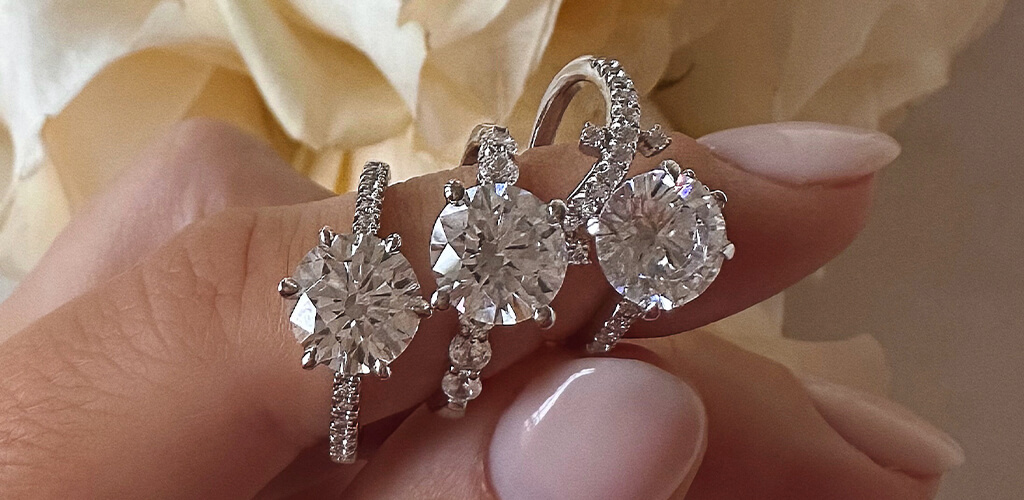
Shopping for an engagement ring is a wonderful yet stressful time. Once you have decided it is the right time, you need to pick out a ring. But not just a ring, you need to choose a diamond, which comes with its own set of factors. Arguably the biggest (yes, pun intended) thing to consider is the carat size of your diamond.
What is the average size and is that the right size for you? Read on to learn what you need to know when choosing the right diamond.
The average carat size for a diamond engagement ring varies widely depending on a number of factors such as location, cultural norms, and personal preferences. According to recent studies, the average carat size for a diamond engagement ring in the United States is approximately 1.2 carats.
It’s worth mentioning, though, that this figure can be affected by factors such as the age and income of the individuals involved and regional differences. Additionally, the trend towards alternative engagement rings featuring gemstones or smaller diamonds has become more popular in recent years.
Ultimately, the size of the diamond in an engagement ring is a personal decision and will depend on individual tastes, preferences, and budget.
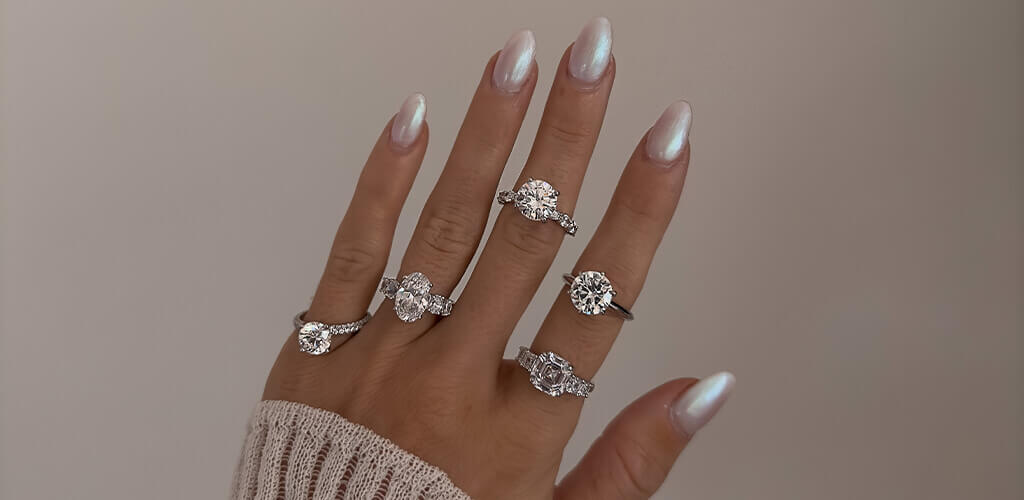
When it comes to finding the right carat size for an engagement ring or any other piece of diamond jewelry, there are several factors to consider. Here are some things you’ll want to keep in mind:
It’s important to establish a budget early on. This will ensure you avoid overspending and focus on diamonds within your budget. The size of the diamond you can afford will depend on multiple factors, primarily the 4Cs. (More on that below).
Bigger does not always mean better. Some people prefer larger diamonds, while others prefer smaller ones. The setting you choose can be an important factor. Certain settings will amplify your diamond, making it appear bigger than its actual carat weight. Make sure to choose a diamond that matches your style and personality because after all, this diamond IS forever.
Not sure about your style? Try before you buy! Testing out different styles, whether in-person or virtually, will help you get an idea of what style of engagement ring and diamond you prefer.
Related post: Try Your Hand at Our Virtual Engagement Ring Try-On
The size of your finger also impacts how your diamond will look on your hand. A larger diamond may overwhelm a small/short finger, while a small diamond may not have as much impact on a larger/wider finger.
Related post: How To Choose The Best Diamond Shape And Size For Your Finger
If you lead an active lifestyle or work with your hands, a larger diamond (as well as certain diamond shapes) may not be practical or comfortable to wear daily. If you plan to wear your diamond engagement ring all day, everyday, then your day-to-day lifestyle is an important factor to keep in mind.
As we said before, bigger is not always better. A smaller diamond of higher quality can often be more impressive than a larger diamond of lower quality. Remember the 4Cs? Cut, color, and clarity are all things to consider, in addition to a carat weight, i.e. size.
Ultimately, the right carat size for you is a personal decision that should be based on a combination of these factors. Take your time, do your research, and work with a trusted jeweler who can help guide you in your selection process.
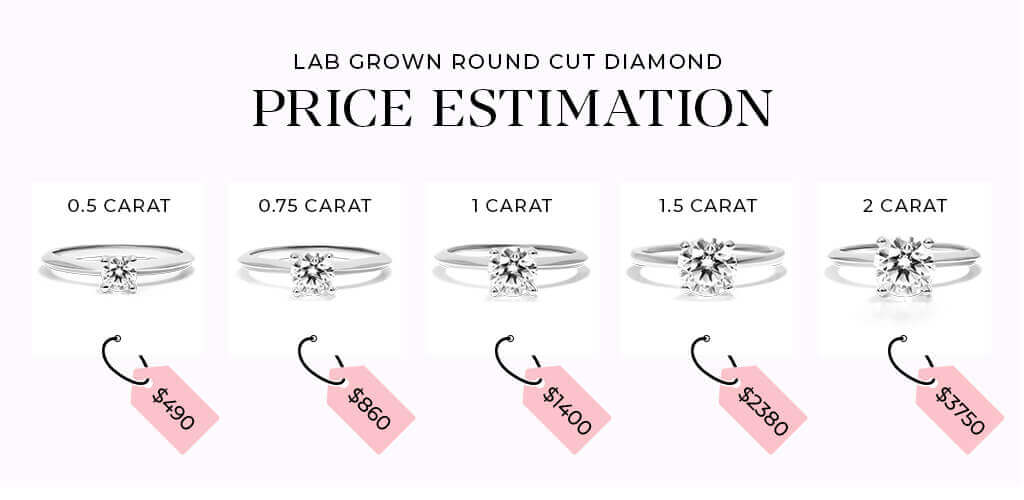
Changing the carat size of a diamond is not a simple process, and it may not always be possible depending on the setting and other factors. Here are a few things to consider if you’re looking to change the carat size of a diamond:
Keep in mind, if the diamond you are looking to change is currently set in a piece of jewelry, there may be a fee to remove/reset it.
It’s important to remember that changing the carat size of a diamond can be costly and may impact the overall value of the diamond. Before making any changes, consider consulting with a trusted jeweler to explore your options and determine the best course of action.
When it comes to diamond cuts, certain shapes can appear larger than other shapes with the same carat weight. This is thanks to how they are cut and how they interact with light. Here are a few diamond cuts that can look bigger than their carat weight suggests:
Oval: The elongated shape of an oval cut diamond can make it appear larger than a round shaped diamond of the same carat weight. Its elongated shape can also make the finger appear slimmer.
Pear: The pointed end of a pear cut diamond can create the illusion of an elongated finger, while the rounded end can make the diamond appear larger.
Marquise: The elongated shape of a marquise cut diamond can make it look larger than a round cut diamond of the same carat weight. The pointed ends can also create the illusion of an elongated finger. Compare the oval and pear shapes to the marquise below:
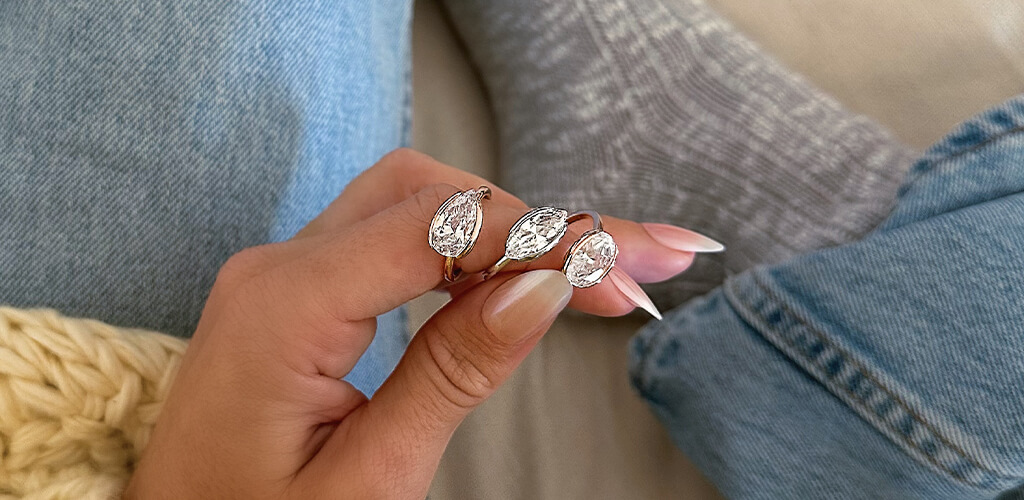
Princess: The square shape of a princess cut diamond can make it appear larger than the popular round cut diamond of the same carat weight due to its square face up appearance.
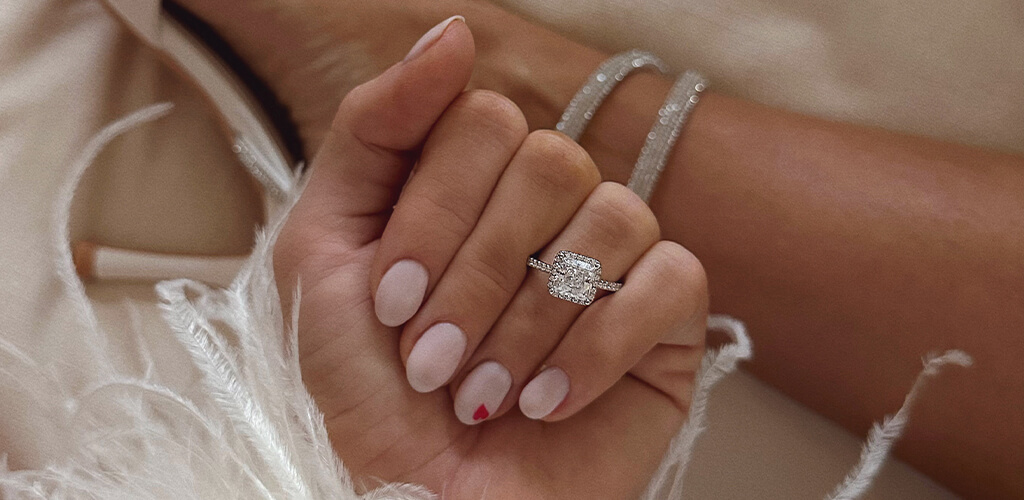
It’s important to keep in mind that a well cut diamond, regardless of the shape, will maximize its brilliance and fire, making it more visually stunning. Ultimately, the diamond that fits your size and sparkle needs is the best one for you.
The amount you should spend on an engagement ring can vary widely depending on factors including your budget and personal preferences. It’s important to remember that there is no set rule for how much you should spend on an engagement ring, and ultimately, the amount you spend should be based on what you and your partner are the most comfortable with.
It has been suggested that you should spend anywhere from two to six months’ salary on an engagement ring, but this is just a guideline and should not be taken as a hard and fast rule.
An important recommendation is to spend an amount that you can comfortably afford without going into debt or compromising your financial goals. On average, most couples budget for anything from $1000 to $6000.
If you’re looking to get the best value diamond for your budget, here are a few tips to consider:
The 4 Cs of diamond quality are cut, color, clarity, and carat weight. While carat weight is often the most visible factor, cut quality has a very high impact on a diamond’s sparkle and brilliance too. Don’t forget to prioritize cut, in addition to a carat weight, and aim for a diamond with a good balance of all 4 Cs.
Different diamond shapes can be priced differently, with round cut diamonds often being the most expensive. Consider looking at other shapes, such as oval or pear, which can offer more value for your budget.
While a diamond with a high clarity grade is desirable, choosing one with a lower clarity grade can offer more value for your budget. And a lower grade does not mean poor quality. In fact, multiple categories of diamonds are part of the “flawless or “near flawless” families.
Consider a diamond with a clarity grade of SI1 or SI2, part of the “slightly included” family, which can offer a good balance of quality and affordability.
Online diamond retailers often offer better value for your money (we can’t argue there!) than traditional brick-and-mortar retailers due to their lower overhead costs. Be sure to do your research and choose a reputable online retailer that offers certified diamonds.
Ultimately, the best way to get the best value diamond for your budget is to do your research, prioritize your preferences and budget, and work with a reputable jeweler to find the best diamond that fits your needs.
Choosing an engagement ring can be a stressful process. Here at JamesAllen.com, we aim to make this as simple, easy, and fun as possible. Keep in mind your budget, your style, and the 4Cs. Do your research, work with a reputable jeweler, and remember that the right carat size is the one that works best for you and your partner.
While big is in the eye of the beholder, a 2 carat diamond is about twice the size of the average engagement ring, which is around 1 carat.
Yes and no. A diamond’s carat size will be a significant factor in determining its cost. However, it is far from the only important consideration when choosing a diamond.
Too big is relative. While a 1.5 carat diamond is larger than the average, what is considered “too big” is personal. If you prefer a more petite diamond of around 0.5 to 1 carat, then yes, it would be too big. However, if you are looking for a larger stone of 2 carats and up, then a 1.5 carat would be too small.
There are many factors to determine the cost of any diamond engagement ring. A lab grown diamond will cost less than a diamond mined from the earth. A diamond with a higher cut, color, and clarity grades will be more expensive than diamonds with lower grades. On average, a 2.5 carat diamond engagement ring will start at approximately $10,000.
Don’t forget that the setting is a factor too! If you go for a sparkly setting, such as pavé or halo, cost more than a more simple setting, such as a solitaire.